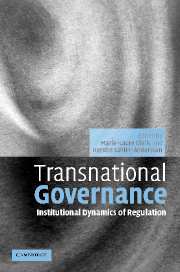Book contents
- Frontmatter
- Contents
- List of figures
- List of tables
- List of contributors
- Acknowledgments
- List of acronyms
- 1 Introduction: A world of governance: The rise of transnational regulation
- I Institutional forces
- II A dynamic transnational topography
- III Transnational governance in the making
- 12 Dynamics of soft regulations
- 13 Contested rules and shifting boundaries: International standard-setting in accounting
- 14 The international competition network: Moving towards transnational governance
- 15 The emergence of a European regulatory field of management education
- 16 Market creation and transnational rule-making: The case of CO2 emissions trading
- 17 Transnational NGO certification programs as new regulatory forms: Lessons from the forestry sector
- 18 Institutional dynamics in a re-ordering world
- References
- Index
12 - Dynamics of soft regulations
Published online by Cambridge University Press: 22 September 2009
- Frontmatter
- Contents
- List of figures
- List of tables
- List of contributors
- Acknowledgments
- List of acronyms
- 1 Introduction: A world of governance: The rise of transnational regulation
- I Institutional forces
- II A dynamic transnational topography
- III Transnational governance in the making
- 12 Dynamics of soft regulations
- 13 Contested rules and shifting boundaries: International standard-setting in accounting
- 14 The international competition network: Moving towards transnational governance
- 15 The emergence of a European regulatory field of management education
- 16 Market creation and transnational rule-making: The case of CO2 emissions trading
- 17 Transnational NGO certification programs as new regulatory forms: Lessons from the forestry sector
- 18 Institutional dynamics in a re-ordering world
- References
- Index
Summary
Introduction
In a speech given in Uppsala on 6 September 2001, in memory of the fortieth anniversary of the death of the late UN Secretary-General, Dag Hammarskjöld, UN Secretary-General Kofi Annan argued that today, in many respects, the activities of the UN follow an agenda established by Hammarskjöld. However, towards the end of his speech, Annan pointed to a fundamental difference between today's world and the one in which Hammarskjöld lived and worked.
So if we go back to the things about today's world that we would have to explain to him, if he unexpectedly joined us now, probably the most difficult for him to adjust to would be the sheer complexity of a world in which individuals and groups of all kinds are constantly interacting – across frontiers and across oceans, economically, socially and culturally – without expecting or receiving any permission, let alone assistance, from their national governments … From this he might well conclude that we should not rely exclusively on state action to achieve our objectives on the international level, either. A great deal, he would think, is likely to depend on non-state actors in the system – private companies, voluntary agencies or pressure groups, philanthropic foundations, universities and think tanks, and of course creative individuals. And that thought would surely feed into his reflections on the role of the United Nations (Annan 2001: 10–11).
- Type
- Chapter
- Information
- Transnational GovernanceInstitutional Dynamics of Regulation, pp. 247 - 265Publisher: Cambridge University PressPrint publication year: 2006
- 23
- Cited by



